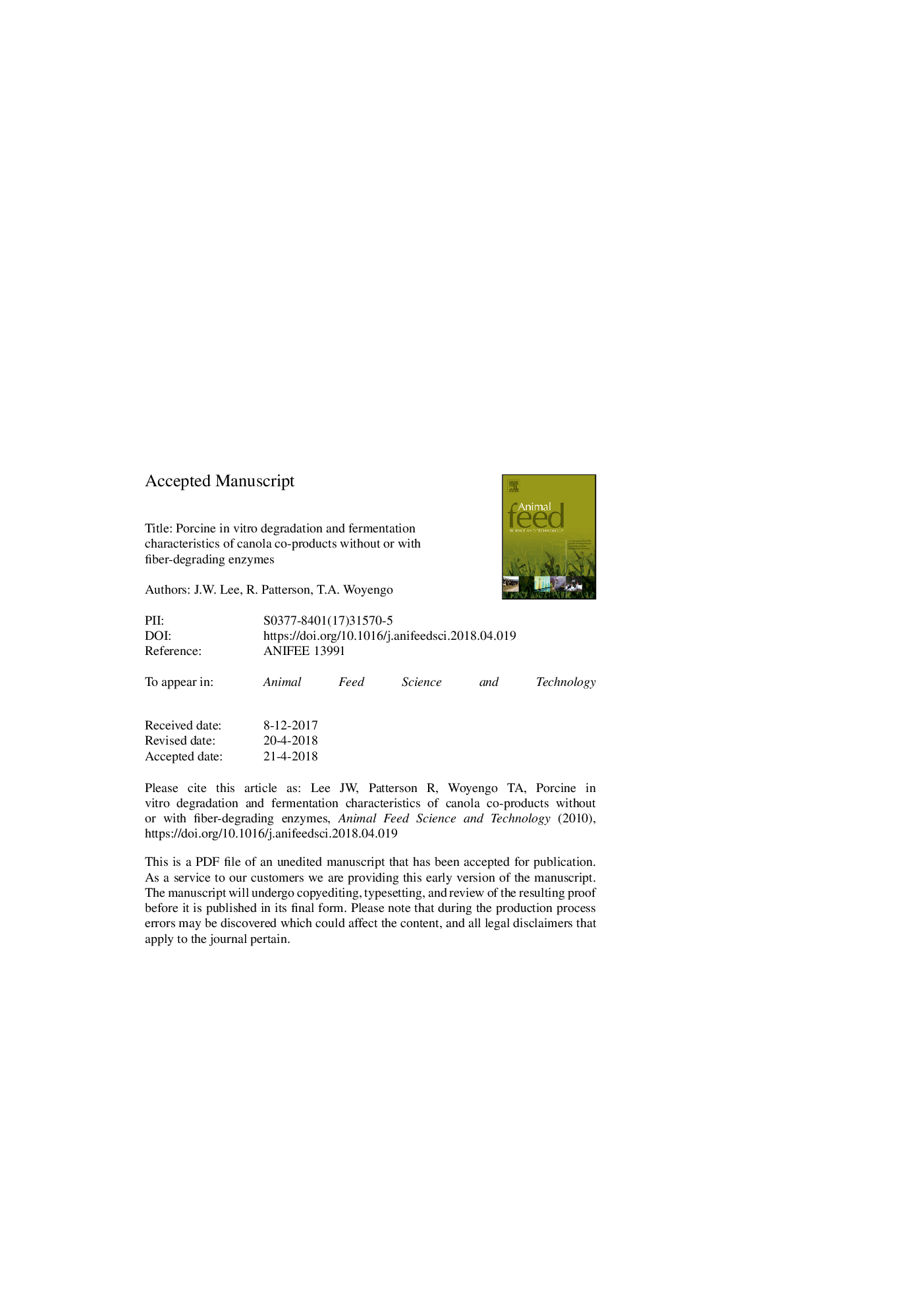| Article ID | Journal | Published Year | Pages | File Type |
|---|---|---|---|---|
| 8490946 | Animal Feed Science and Technology | 2018 | 29 Pages |
Abstract
An in vitro study was conducted to determine the effects of supplementing solvent-extracted canola meal (SECM) and cold-pressed canola cake (CPCC) with fiber-degrading enzymes (multi-enzyme) on porcine in vitro digestion and fermentation characteristics. Canola co-products without or with multi-enzyme (Superzyme-CS, Canadian Bio-Systems Inc., Calgary, AB, Canada) that supplied 24,000â¯U of xylanase, 3000â¯U of glucanase, 10,000â¯U of cellulase, 1200â¯U of mannanase, 14,000â¯U of invertase, 10,000â¯U of protease, 24,000â¯U of amylase and 8,500â¯U of pectinase/l of incubation medium were digested using porcine pepsin and pancreatin. Undigested residue was subjected to in vitro fermentation for 72â¯h. Accumulated gas production during microbial fermentation was recorded and modeled to estimate kinetics of gas production. Total volatile fatty acids (VFA) concentration per unit weight of DM of enzymatically unhydrolyzed residue incubated, and per unit weight of DM feedstuff that was enzymatically hydrolyzed and then fermented was also measured. On a DM basis, CPCC and SECM contained 318 and 451â¯g/kg CP, respectively. The in vitro digestibility of DM (IVDDM) for CPCC was greater (Pâ¯<â¯0.05) than that for SECM (0.635 vs. 0.584, respectively). Multi-enzyme supplementation tended to improve (Pâ¯=â¯0.060) the IVDDM regardless of canola co-product type. Total gas production for CPCC was less (P<0.05) than that for SECM (89.3 vs. 106.0â¯ml/g, respectively). Multi-enzyme reduced (Pâ¯<â¯0.05) total gas production for CPCC and SECM. Total VFA production for CPCC was lower (Pâ¯<â¯0.05) than that for SECM (2.89 vs. 4.43â¯mmol/g DM of enzymatically unhydrolyzed residue, respectively). Total VFA production for CPCC was also lower (Pâ¯<â¯0.05) than that for SECM (1.07 vs. 1.82â¯mmol/g DM of feedstuff, respectively). Multi-enzyme did not affect total VFA concentration per unit weight of enzymatically unhydrolyzed for canola co-products but tended to reduce (Pâ¯=â¯0.058) total VFA production per unit weight of feedstuff. In conclusion, CPCC was more digestible but less fermentable than SECM. Multi-enzyme supplementation improved the IVDDM and reduced total gas and VFA production for CPCC and SECM. Thus, multi-enzyme shifted the digestibility of CPCC and SECM from microbial fermentation towards enzymatic digestion, implying that the multi-enzyme improved efficiency of utilization of nutrients in the two canola co-products.
Keywords
ACANSPcpccAOACPPABCFADDGSSBMSECMVFANDFIVDDMADFAcetic acidButyric acidPropionic acidbranched-chain fatty acidsVolatile fatty acidsacid detergent fibreassociation of official analytical chemistsBtAin vitro fermentationPigdistillers dried grains with solublesIn vitroether extractneutral detergent fibredry mattercrude proteinnon-starch polysaccharidesCarbohydrasesSoybean mealDigestion
Related Topics
Life Sciences
Agricultural and Biological Sciences
Animal Science and Zoology
Authors
J.W. Lee, R. Patterson, T.A. Woyengo,
